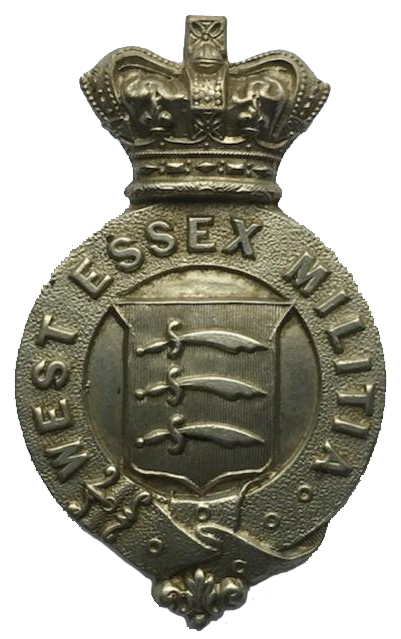Essex’s fearsome flag was included on the registry from its inception, in the early years of the 21st century. The three white seaxes (short Saxon swords) with gold pommels on a red field were the arms ascribed to the ancient kingdom of the East Saxons, or Essex, by Richard Verstegan, who, in his 1605 work “A Restitution of Decayed Intelligence”,

printed in Antwerp, stated that “Erkenwyne king of the East-Saxons did beare for his armes, three [seaxes] argent, in a field gules” i.e. three short Saxon swords on a red background. He cited no authority for his assertion but appears to have been confident about it. John Speed subsequently included the arms in his 1611 atlas, “The Theatre of the Empire of Great Britaine” where they appear on the title page of the work

and twice on a map of the Anglo-Saxon heptarchy, once on a decorative column at the left of the page, denoting the “founders” of the Anglo-Saxon kingdoms, where “Erkenwyn” is seen holding a shield bearing the design
and again on the actual map
John Speed qualified the description that they were used by the ancient East Saxon kings with the phrase “as some of our heralds have emblazed”.
He includes the Essex seaxes again, in quasi flag or banner form,

in his “History Of Great Britaine” (also from 1611, reprinted in 1623).
There is, as yet, no definitive origin for the three seaxes as the arms of the Kingdom of Essex. It is believed that the name of the nation of the Saxons was itself derived from the Seax, the form of weapon

for which they were best known, so it is logical that the weapons might be chosen as a reflection of the name. One theory has been propounded by historian James Lloyd whose research unearthed a mediaeval manuscript (Harley 2169) originating in the reign of Henry VI (1421-1471). This includes a set of arms ascribed to the Anglo-Saxon Heptarchy, the seven kingdoms of the Anglo-Saxon era from approximately the late fifth century to the ninth. Remarkably, the arms featured in this work for the Kingdom of Kent, depict three seaxes! White on a red background.

 Lloyd has proposed two theories regarding this set of arms. In the first he contends that the mediaeval herald who completed this work, following the contemporary practice of referring to Hengest and Horsa, the legendary founders of the Kingdom of Kent, as generic “Saxons”, may have invented the seaxes as “canting arms“, where the devices on a shield are visual references to the names of the people who bear them – this is a common heraldic practice; the herald assigning these to Kent on the grounds that that was the first “Saxon” kingdom to be established. Alternatively, he suggests that the design may commemorate a gruesome but significant chapter in the annals of the founding of the kingdom, the so-called “Treachery of the Long Knives“, recorded by Nennius and made famous by Geoffrey of Monmouth, when Hengest’s forces, gathered to negotiate with the Brittonic (British or ancient Welsh) ruler Vortigern, concealed their seaxes under their cloaks. Hengest is reported to have cried out “Nimat eowre seaxes”, (Take out your seaxes.) as the signal for his men to kill the Britons. The herald who devised the arms bearing these three seaxes may have had this infamous incident in mind.
Lloyd has proposed two theories regarding this set of arms. In the first he contends that the mediaeval herald who completed this work, following the contemporary practice of referring to Hengest and Horsa, the legendary founders of the Kingdom of Kent, as generic “Saxons”, may have invented the seaxes as “canting arms“, where the devices on a shield are visual references to the names of the people who bear them – this is a common heraldic practice; the herald assigning these to Kent on the grounds that that was the first “Saxon” kingdom to be established. Alternatively, he suggests that the design may commemorate a gruesome but significant chapter in the annals of the founding of the kingdom, the so-called “Treachery of the Long Knives“, recorded by Nennius and made famous by Geoffrey of Monmouth, when Hengest’s forces, gathered to negotiate with the Brittonic (British or ancient Welsh) ruler Vortigern, concealed their seaxes under their cloaks. Hengest is reported to have cried out “Nimat eowre seaxes”, (Take out your seaxes.) as the signal for his men to kill the Britons. The herald who devised the arms bearing these three seaxes may have had this infamous incident in mind.
James Lloyd’s extensive study of Kent’s white horse has concluded that Richard Verstegan, in his above work, later assigned the white horse to Kent on the basis of a set of prevailing ideas and then re-assigned the above three seaxes emblem to Essex, based on the etymological link between the name of that kingdom and the seaxes depicted.
The seaxes of the Kingdom of Essex then appeared in an account of the Anglo-Saxon Heptarchy “Divi Britannici”

by Sir Winston Churchill (direct ancestor of the famous twentieth century one), published in 1675 and have subsequently been regarded as the emblem of the kingdom, turned county, of Essex for centuries. This recognition is reflected in their inclusion in Joshua’ Price’s design of the West Window installed in Westminster Abbey in 1735

King Sebert of Essex is said to have founded a church on the site in 604, whence the Abbey developed over the centuries and an arched recess in the building
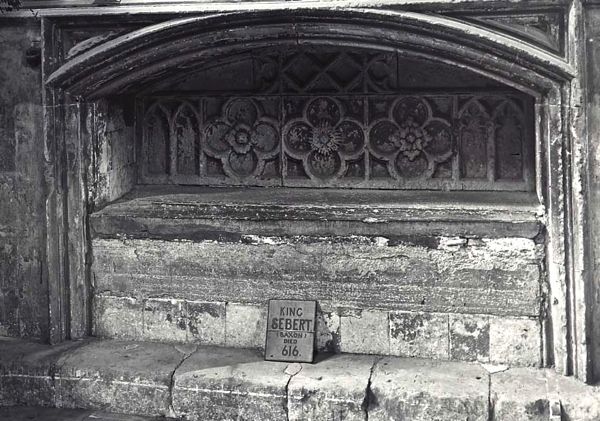
contains the remains of the ancient king of the East Saxons, whose territory at that time encompassed Middlesex and Hertfordshire; the Essex arms appear on the window in token of this association and origin. Interestingly, although it has been contended that the original form of the seaxes was with their notches turned up, Speed depicts them both with notches upturned, as on his map and its decorative panel and facing down, as on the title page depiction and in his later work. In the 1675 example, although without notches, the seaxes appear to have the same upwards inclined orientation but curiously are depicted unconventionally, with their points to the observer’s left. They are clearly seen “upwards” on the stained glass; a degree of variation in these early depictions is evident.
Several ensuing examples demonstrate the extent to which the arms were recognised as symbolic of the county; in 1770, Peter Muilman published the first volume of his History of Essex, on the front was a female figure with a shield by her side bearing three seaxes;

they later appeared on the masthead of the Chelmsford Chronicle, as seen on this edition dated Friday, July 14th, 1815;
and they were used on its fire plate, by The Essex Equitable Insurance Society, established in Colchester in 1802
The device was further adopted by the Essex Militia
and Essex Volunteers
 in the same era and other county miltary units
in the same era and other county miltary units
 The emblem then appeared on a print of Braintree Market in 1826
The emblem then appeared on a print of Braintree Market in 1826 Another county based organisation to use the emblem was the Essex Archaeological Society
Another county based organisation to use the emblem was the Essex Archaeological Society
founded in 1852. A formal coat of arms was awarded to the body, re-designated as the Essex Society for Archaeology and History, in 2010
which reworks the three seaxes of the county and appears to mimic the orientation and general appearance of the blades seen on the above, mediaeval, Harley manuscript. Three Saxon crowns are also included, possibly indicating a connection with East Anglia?
The seaxes can also be found on two low columns
flanking the entrance to the Battlesbridge Antiques Centre, in the county,
constructed in 1860 and it is carved into the stonework of the bridge over the Stour at Wormingford Mill, which forms the boundary with Suffolk.

on the Essex and Suffolk Fire Office, Colchester,

the onetime headquarters of the Essex and Suffolk Equitable Insurance Society.
Originally constructed in 1820 as a corn exchange, a third storey was added in the early twentieth century when the building was assigned its new purpose. The additional storey included the Essex emblem


to indicate the company’s county based remit.
A further example from this era is their appearance on the front cover of the 1905 publication, “Picturesque Essex”, by Duncan Moul and R.H. Ernest Hill

The status of the three seaxes as the arms of Essex is acknowledged by heraldist Arthur Charles Fox-Davies, in his 1915 work ‘The Book of Public Arms”

which also includes an image of the emblem
The emblem was effectively used as a coat of arms, albeit without legal sanction, by the council established for Essex in 1889; one example is this sign

on the bridge over the River Brain
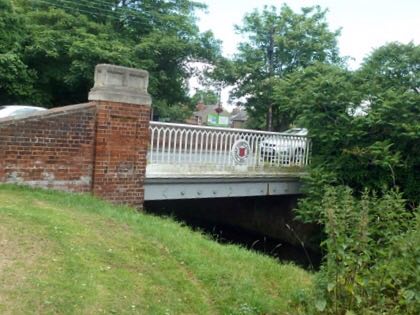
in Witham, dated 1900 and another example of the Essex seaxes from this era is found on a wall plaque next to “The Brave Nelson” pub in Brentwood (photo from Terry Munnerley)
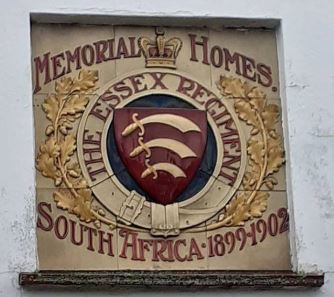
Another example of council usage is this marker
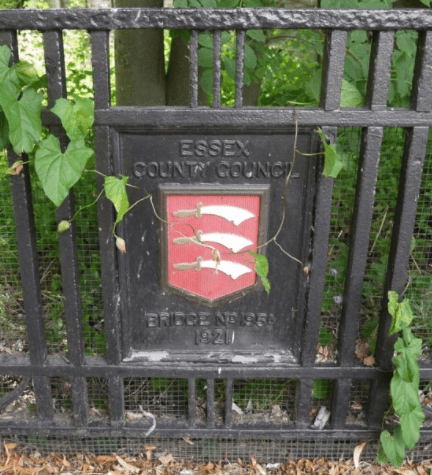
dating from 1921, marking the boundary between the boroughs of Barking & Dagenham and Havering. The council was subsequently awarded a formal grant of the arms

in 1932.
However, as they had already been in the public domain, well before the creation of the council, an armorial banner formed from these anciently attributed arms could not be restricted to the council’s use but as with the arms from which it was derived, represented the whole county as an entity. In the twenty-first century therefore the Flag Institute accepted that the armorial banner of the shield bearing the three seaxes, was the county flag. Interestingly, the Essex council arms feature no supporters, crest, motto or other adornments typical of a heraldic award, the plain decorated shield, of ancient renown, being used alone. Such plain arms are a rarity in heraldry and usually typify arms of antiquity before the development of such additional features.
The old Kingdom of Essex stretched further inland towards the Midlands and covered territory now in Middlesex and Hertfordshire
 Accordingly, the same arrangements of three seaxes on red was used in Middlesex for centuries until its county council sought a distinctive arrangement of its own, and was awarded amended arms, distinguished by the addition of a Saxon crown in chief, (at the top of the shield) over the seaxes, in 1910.
Accordingly, the same arrangements of three seaxes on red was used in Middlesex for centuries until its county council sought a distinctive arrangement of its own, and was awarded amended arms, distinguished by the addition of a Saxon crown in chief, (at the top of the shield) over the seaxes, in 1910.

The original form of the arms was retained in the former badge of Middlesex County Cricket Club,
replaced in 2017 and the current Middlesex Rugby club badge
The depiction of the blades themselves seems to have evolved over the years. Whilst some assert that the notches seen on the blades in the Essex flags were used to prise open oysters, a common food on the Essex coast, they are not present on existing seaxes, such as this one

displayed in the London museum (missing the original wooden handle). Gouging chunks out of a weapon like this would seemingly weaken its solidity and usefulness. Existing examples of seaxes
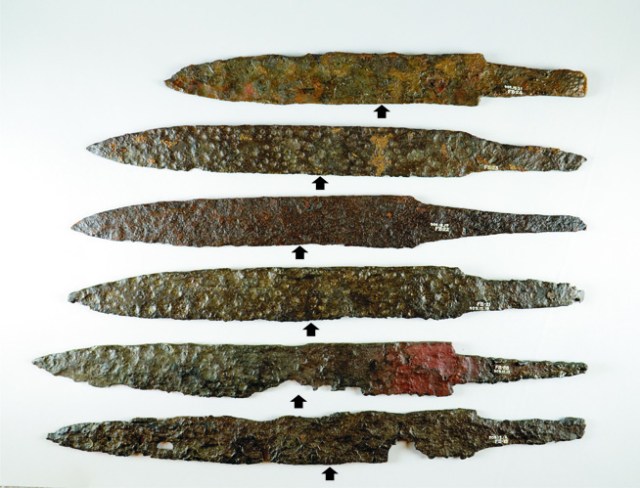
are also not curved like scimitars. These characteristics seem to be the products of 19th century heraldic fashion!
Diana Willment, considering the form of the seaxes appearing on the Middlesex emblem but with an equal bearing on those used in Essex, writes on the Brentford history blog,
“I have long been intrigued by seaxes. Why do the blades each have a huge notch in the back? What blacksmith would damage the strength and flexibility of his fine forgework in such a way? What could be more impractical in use? A quick trip to London Museums found 5 genuine seaxes, although the perishable hilts do not survive. A trawl through the internet confirmed my findings. The seaxe was not a curved scimitar missing a disfiguring bite but a strong and practical weapon and tool. The blades varied in length from 3 to 30 inches and were straight, unnotched and very sharp. They were solidly triangular in cross-section with a long and lethal point; the larger ones were quite heavy. A few were decorated with linear designs near the back, a very few had an owner’s name.
So when did the notches appear? Next a visit to the College of Arms. Here it was clear that seaxes in early heraldry were straight and unnotched. Only later did they become curved and notched. There was apparently a gradual transition during the 19th century. Possibly there were in that century Heralds of an artistic turn of mind who had, or sought, no access to the genuine article.
The last question was why did the notches appear? The only clue I came across was a description of the seaxe as sometimes grooved. Some blades had lengthwise grooves along or near the back. There could be several reasons for this, one being to lighten it as a weapon. A carefully designed groove would not necessarily reduce the strength of the blade, unlike a notch which cuts across the inner patterning and can only weaken its structure. There is the possibility that at some time “groove” became confused with “notch” with the result we see. A misunderstanding…”
As touched upon above, another consideration is the orientation of the blades, cutting edge turned up or down? It is interesting to compare the seaxes of 1905’s “Picturesque Essex”,

where the seaxes point down, with those on its sister companion to Middlesex

where they are turned up, hinting that this practice may have evolved, to some degree, as an early means of distinguishing emblematically, between the two counties. The “sharp edge” down depiction seems to have been used predominantly in Essex and is the one which has prevailed in both counties, in the modern era.
Further examples of the Essex seaxes are the badges of the county cricket club;
the county bowling association;

the county rugby;

football;

and hockey

associations;
two medical organisations;
the county’s police force

and fire and rescue service

And the county emblem is also present on this badge worn by nursing staff in the county

The seaxes further appear in the arms
 and logo
and logo
of the University of Essex and they were incorporated into the emblem of the

Metropolitan Railway, alongside the emblems of Buckinghamshire and Hertfordshire and the arms of the City of London.
The Essex arms can be found today on a stained glass window in Chelmsford Cathedral,
boldly announce entry into the county
and appear on a car flag for the Essex High Sheriff, in a manner similar to John Speed’s 17th century example, as a shield against a blue background, within the title of the office.

And a seax or two feature on the civic arms of several Essex towns awarded in recent decades

A pub in Brentwood is named for the county emblem
as is another in Huntley, New Zealand (!)

both of which prominently display the three seaxes. In 2014, these made a decorative appearance

at the UK leg of the Tour De France, when they were recoloured to match the colours of the race shirts!
The county flag appears on this memorial plaque,
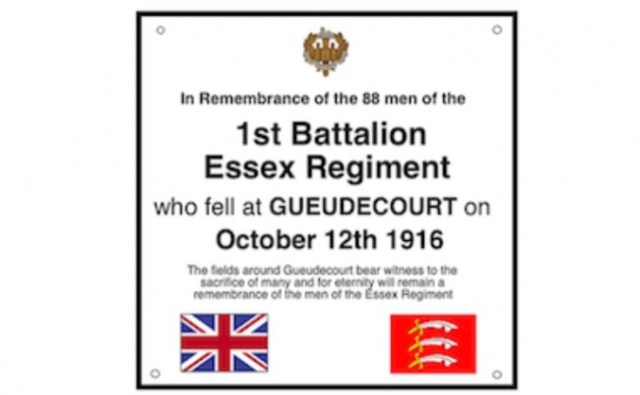
created to honour the fallen of a county regiment in World War One.
The Essex flag is frequently unfurled on vessels
and in sporting contexts


It can be found flying or displayed around the county

, over the Glastonbury crowd

and other similar events

and has been unfurled at the county’s highest point, “High Wood”.

The flag is seen below


alongside the flag of Suffolk on a footbridge spanning the River Stour, forming the counties’ mutual boundary and below
the flags of the three counties of Suffolk, Essex and Cambridgeshire are seen together at the tripoint where they converge.
Recent years have also seen the flag hoisted with marked enthusiasm to celebrate Essex Day, October 26th, Feast Day of Saint Cedd. It was raised in 2017 by Basildon councillors

and again in 2019

2019 also saw the flag hoisted by Havering Borough Council

The Essex seaxes
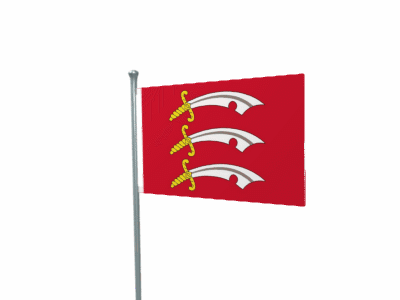
have also been adapted by the West Mersea Yacht Club for its own flag

and burgee

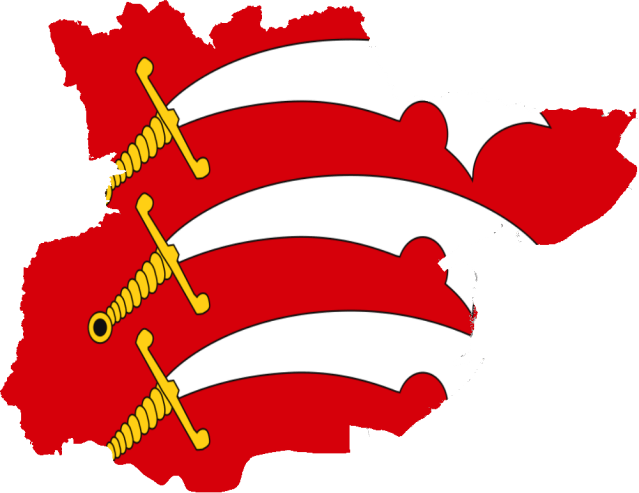
Useful Links







